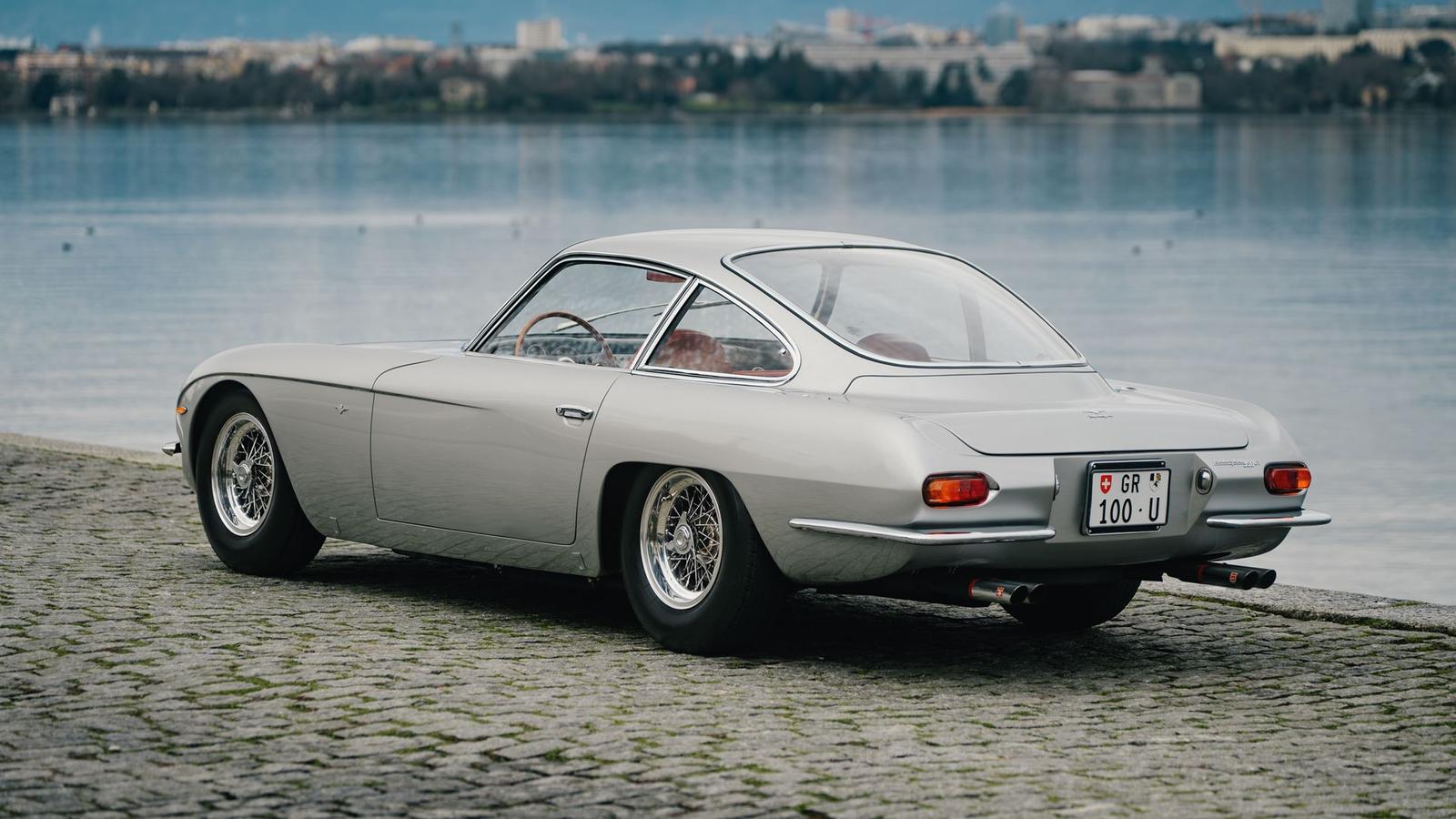After all these years, everyone is now well aware of the Lamborghini and Ferrari rivalry. Ferruccio Lamborghini was passionate about brand-new car models and owned two Ferrari cars as well. His experience with Ferrari could have been better. He felt that the clutch of these cars broke very quickly. For this reason, he headed to Enzo’s residence and, in 1962, told him about the bad condition of the clutch.
Instead of listening to constructive criticism, Enzo said, “The clutch is not the problem. The problem is you don’t know how to drive a Ferrari and you break the clutch.”
Ferruccio was offended and said he would never repurchase Enzo’s cars. Ferruccio said he would make his cars and ensure they worked how he wanted them to.
After throwing this challenge to Enzo, on October 29, 1963, Ferruccio Lamborghini unveiled the 350 GTV at his newly built factory in Sant’Agata. The 350 GTV, which later evolved into the 350 GT (production variant), featured a new design and a completely new V12 powertrain, considered one of the smoothest V12 engines because Ferrucio’s intention was never to build a sportscar but an easy and powerful road car.
That said, Here are 10 reasons why the Lamborghini 350 GT GT Reigns as the Pinnacle of Lamborghini’s Automotive Heritage
10. New Exterior Design Built from Scratch…

The Lamborghini 350 GT was the automaker’s first car. However, a prototype was presented at the 1963 Turin Auto Show before its official launch.
The original designer of the prototype was Franco Scaglione, who had created even more dramatic concept drawings. Unfortunately, Ferruccio Lamborghini, the founder of Lamborghini, was not pleased with the prototype’s appearance and wanted a complete styling overhaul. He shared his ideas with Bianchi Anderloni from the renowned Carrozzeria Touring, who transformed the prototype into a viable production model known as the 350 GT.
To reduce manufacturing costs, the angular design of the front and rear of the GTV was softened in the GT version. However, the large rear window was retained. Additionally, significant changes were made to the exterior of the production model, including the replacement of the prototype’s unique rotating headlights with fixed oval-shaped units from Cibie (although some sources cite Bosch or Hella).
9. The Interior space management concept came into existence.

Neri & Bonacini modified the chassis of the 350 GTV for the production version. During this process, the wheelbase was increased by 100mm to 2550 mm and the overall length by 140mm to 4640mm, increasing the interior space for the two occupants.
It’s worth noting that some early 350 GT models came in a 2+1 configuration, featuring a small seat mounted in the rear instead of the usual shelf that could hold additional luggage. In the two-seat configuration, the rear shelf even offered a pair of straps to keep the luggage from moving around while driving.
8. The production version was made lighter for better performance
The first Lamborghini prototype, 350 GTV, had a steel and aluminum body. However, the 350 GT model was built using Touring’s patented Superleggera method. This involved mounting thin aluminum panels over a tubular frame to reduce weight. As a result, the Lamborghini 350 GT weighed only 1050 kg.
The famous 72-spoke Borrani wheels remained the same size at 15 inches. However, not all 350 GTs had an aluminum body. Towards the end of production, preparations were made to build the 400 GT 2+2, and the last 350 GTs were delivered with steel bodywork.
7. The Introduction of the Legendary V12 Engine

After successfully designing the exterior of the Lamborghini 350 GT, the team shifted their focus towards the engine to ensure that it could deliver a trouble-free performance for at least 70,000 kilometers (40,000 Miles) between maintenance intervals.
The renowned engineer Giotto Bizzarrini developed a V12 engine that produced an impressive 360 horsepower at 8,000 revolutions per minute (RPM). Some sources even claimed it could reach 400 horsepower at 11,000 RPM. This was possible using high-end vertical 36mm Weber carburetors, a dry sump oil system, and a high compression ratio of 11:1.
To make the V12 engine production-ready, Chief Engineering Gian Paolo Dallara and Bob Wallace collaborated to modify it. The new engine could deliver 280 horsepower at a lower RPM of 6,500, thanks to the implementation of a wet sump lubrication system and a compression ratio of 9.5:1.
6. The Performance numbers were pretty insane!

To supply the required 100 Octane fuel, two electric Bendix fuel pumps were used to provide fuel to six dual 40DCOE 2 Weber carburetors. With this new configuration, the Lamborghini 350 GT could reach a top speed of 250 kilometers (155 Miles per hour) and accelerate from 0-62 Mph (0 to 100 kilometers) in just 6.8 seconds.
These were some imposing figures, especially considering they were achieved in the early 1960s.
5. The Dropping of the ‘V’ Suffix

The Lamborghini 350 GT significantly departed from the original GTV. Its design was radically different, prompting Lamborghini to remove the ‘V’ (for Veloce) from the nameplate.
The 350 GT was unveiled at the 1964 Geneva Auto Show, five months after the prototype debuted at the 1963 Turin Motor Show.
Despite the short period, the transition from prototype to production was seamless, and it quickly became evident that the changes made were successful. Orders began pouring in, and production could start on actual customer cars. The 350 GT was an instant success, and its powerful V12 engine and luxurious interior made it a favorite among wealthy car enthusiasts.
4. The 350 GT has several versions.

One of the most interesting facts about this 350 GT is that it comes in several different versions, each with unique features and specifications.
Chassis Number #0100: The Lamborghini 350 GTV was built on number #0100.
Chassis Number #101: The 350 GT unveiled at the March 1964 Geneva Auto Show was given the number #101 and had a Touring body (#17001).
Chassis Number #104: Interestingly, the first customer car was chassis #104 with body #17004, delivered on July 31, 1964, marking the official beginning of Automobili Lamborghini SpA as a car-building factory.
3. The Mishap with Lamborghini 350 GT Chassis Number #0101 and the comeback..

Although Chassis number #0101 featured plenty of new features, it was Lost in a mishap:
Triple exhaust pipes
It’s worth noting that the Geneva Show car #0101 was the only one with triple exhaust pipes, like the ones on the GTV.
Unique rear badge
Additionally, it came with a unique rear badge that read “350 GT 2+1” because it had a third seat at the rear. After this, no other 350 GT would be delivered with this badge.
Unfortunately, the original show car was lost during a test drive accident and never rebuilt. As a result, chassis number #102 became the oldest Lamborghini.
However, #102 and #104 were delivered before #102, all factory-development cars. Chassis #106 was the first Lamborghini 350 GT built to order with specific customer-requested options.
2. Scope Of Modification in 1966

In 1964, Lamborghini delivered 13 units of the 350 GT to customers. The first car was coated in silver metallic. At the same time, the later versions of the 350 GT had a more prominent front air intake divided into two horizontal sections, and the bumper was split into two pieces, leaving the center open for better cooling. Depending on where the 350 GT was sold, some bumpers were equipped with overrides for better protection. The car also had one round vent in the beginning, which was later replaced with two vents in front of the windshield. At the rear, a backup light was mounted under the license plate holder.
During the Lamborghini 350 GT production, customers could choose a dual windshield wiper configuration instead of the original single one. Some sources indicate that the two wipers were installed in cars sold in the USA only, while others suggest that only the 400 GT 2+2 had the double wiper option. However, it turned out to be a ‘no cost’ option.
The central console of the car features a polished aluminum panel that houses four dials. In the later 350 GT models, this panel was upgraded to match the leather finish of the rest of the dashboard. However, some cars had a wood-like vinyl plaque behind these dials, while others had a black painted plate. Since these cars are several decades old, it can be difficult to determine what is original and what has been added during a restoration process.
1. Lamborghini Even Provided an option to upgrade the engine

In 1966, Lamborghini introduced the 400 GT, an upgraded version of the 350 GT with a more powerful 4.0-liter engine (320 hp compared to 280 hp). Despite looking almost identical to the 350 GT, the 400 GT was a significant improvement in terms of performance. Interestingly,
Lamborghini even reached out to 350 GT owners to offer them an upgrade to the new 4.0-liter engine. This means it’s possible to find a 350 GT with a more powerful engine, blurring the lines between the two models. In addition, it’s worth noting that the 400 GT 2+2, a separate model, offered two more seats and a unique design. This is a prime example of the Italian automotive world’s dedication to performance and innovation.



